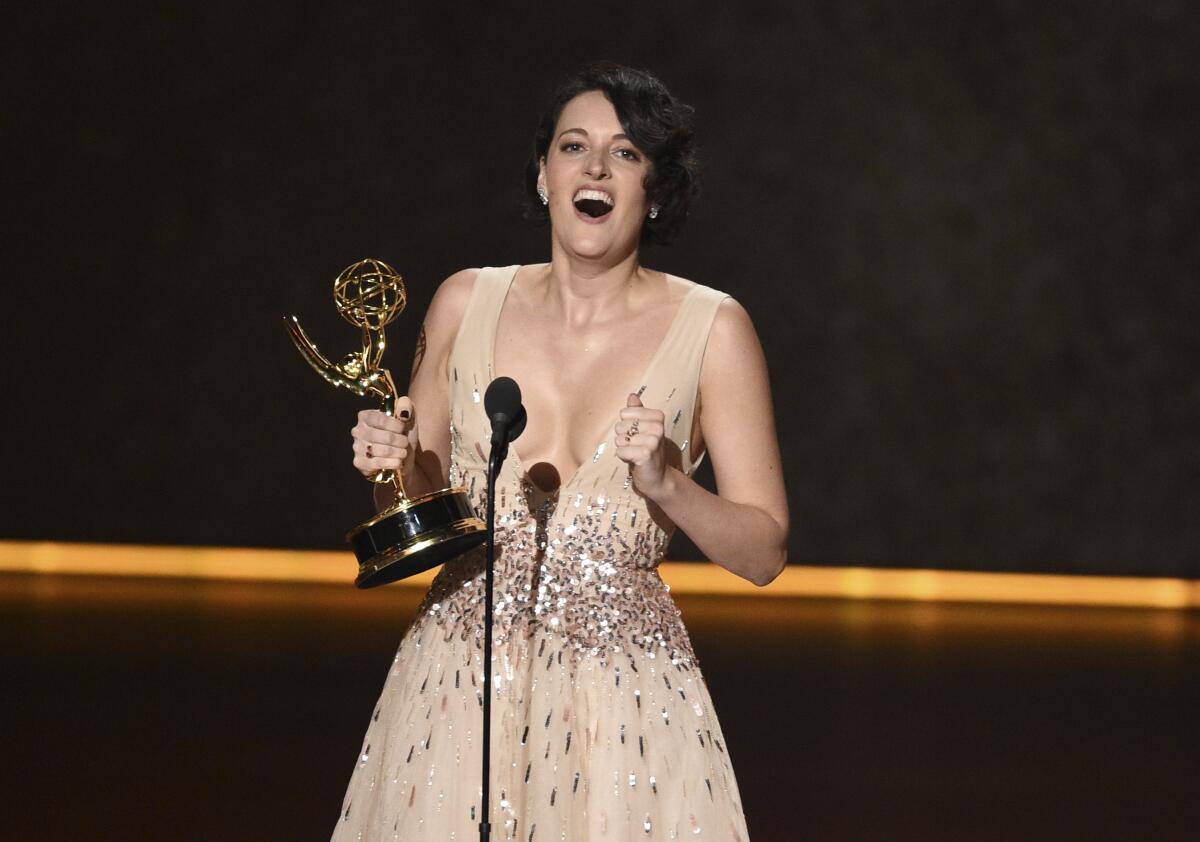We looked into the diversity of recent Emmy nominees. The numbers are not great

- Share via
Tuesday’s announcement of the 2020 Emmy nominations comes at a moment of heightened attention to diversity and representation in TV, prompted by protests over the death of George Floyd and the Black Lives Matter movement more broadly. But while the TV Academy has not faced a high-profile controversy like #OscarsSoWhite, a Times analysis of nominees for television’s most prestigious prize from the past five years reveals that those honored for the medium’s most “outstanding” work remain overwhelmingly white.
From 2015 to 2019, 82% of the nominees in 19 prime-time Emmy categories were white, including more than three-fourths of the acting nominees and fully 90% of the writing and directing nominees.
Categories studied included the 12 major acting categories, the writing and directing categories for comedy, drama and limited series, and directing for variety series. (Writing for variety series, for which entire staffs are nominated together, was omitted.) Black people accounted for 14% of nominees overall. Asian nominees were 2% of the total, Latinos 1%, and all others a combined 1%.
By contrast, according to the U.S. Census Bureau, non-Hispanic whites are 60% of the population, Latinos 18%, Black people 13%, Asian/Pacific Islanders 6% and American Indians 1%. (An additional 3% of people identify as two or more races.)
“As an organization which is open for membership to all individuals working in the television industry, the Television Academy fervently agrees that there is still much work to be done across our industry in regards to representation,” the academy said in a statement to The Times. “We feel it is a very positive sign that over the past decade the well-deserved recognition of performers of color has increased from 1 in 10 to 1 in 3 nominees across all performer categories. Clearly that increase in representation has not been equal for all groups, and clearly there is still more to do to improve both gender and racial representation across all categories.”
Perhaps most glaringly, there have been no Latino performers among the lead and supporting nominees for comedy or drama series in the last five years. Those in the Hispanic/Latino category comprise the largest ethnic minority in America.
Candidates during that time have included the casts of the acclaimed “Jane the Virgin” and “One Day at a Time,” Stephanie Beatriz in “Brooklyn Nine-Nine,” Bobby Cannavale in “Homecoming,” America Ferrera in “Superstore,” and Wagner Moura, Pedro Pascal and Michael Peña of Netflix’s “Narcos” franchise, among others. The TV Academy has nominated a number of Latinos in the limited series/TV movie categories in that period, including last year’s winner for “When They See Us,” Afro-Latino actor Jharrel Jerome.
The dearth of diversity in the Emmy nominations reflects underrepresentation of women and people of color in the industry more broadly. For instance, UCLA’s 2019 Hollywood Diversity Report found that approximately 21% of broadcast, cable and digital scripted leads were people of color — versus 40% of the population — and 42% were women — versus more than 50%. As for the Television Academy’s own makeup, a spokesperson told The Times that the organization does not require its members to furnish racial/ethnic identification.
While the Screen Actors Guild also does not require its members to provide demographic information, it is possible to compare the data on the Emmy nominees from 2015 to 2019 with statistics from other industry guilds.
According to the Writers Guild of America’s 2020 WGAW Inclusion Report, 65% of people “holding ... TV writing jobs” in 2018 were white. Latinx people were again sorely underrepresented, accounting for just 8.7% of the total.
That divide becomes greater when positions of authority are counted separately. White writers account for 82% of showrunners and 81% of executive producers, while writers of color make up the majority of executive story editors and story editors and are approximately at parity with whites at the level of staff writer. Meanwhile, men hold 70% and 76% of the showrunner and executive producer jobs, respectively; women account for 57% of staff writers.
The Directors Guild of America says director members of color account for 11% of its ranks. The DGA does not make hiring recommendations to studios and networks but does include language encouraging diversity in guild-signatory contracts.
According to the DGA, whose director membership is 82.5% male, women directed 31% of TV episodes in 2018-19, up 6% from the year prior. Women also accounted for 49% of all first-time hires during the 2018-19 season. Yet in the writing and directing Emmy categories, men received 85% of the nominations.

As for trends, the proportion of people of color nominated in the acting, writing and directing categories, and the proportion of women in the writing and directing categories, remained relatively stable over the five years studied. (Women did make up a more significant percentage of last year’s crop of nominated writers, though — thanks in large part to three series, “Fleabag,” “Russian Doll” and “PEN15,” that are not eligible in 2020.) As the TV Academy noted in its statement, the representation of people of color in the performer categories has improved more substantially if one looks at the past 10 years instead of the last five.
Given recent events, it’s reasonable to expect that Emmy voters — who are not immune to the tenor of the times — will honor a greater number of people of color and women than in past years in some major categories; among the series predicted to make a strong showing are “Pose,” “Watchmen,” and “Little Fires Everywhere.”
More to Read
The complete guide to home viewing
Get Screen Gab for everything about the TV shows and streaming movies everyone’s talking about.
You may occasionally receive promotional content from the Los Angeles Times.







